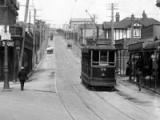What happened that day?
See historic events for any day of the year by entering the date below. Why not try your birthday?
Kiwi of the Week
Today in History

1878 Wellington steam-tram service opened
The Governor, the Marquess of Normanby, formally opened the new service, which was reportedly the first to operate in the Southern Hemisphere. The steam trams proved unpopular, though, and were later replaced by horses.
The Wellington Tramway Company had begun operating three days earlier, on 21 August. Its three small steam engines, named ‘Hibernia’, ‘Wellington’ and ‘Zealandia’, each hauling a passenger tramcar, ran from a terminus on Lambton Quay via Cuba and Vivian Streets to the company's depot in King Street, off Adelaide Road. The trip took half an hour and cost threepence. The fleet later grew to eight engines, but they were not universally appreciated.
The steam trams were criticised for being 'noisy, dirty, frightening to horses, and prone to derailment'. As economic depression took hold at the end of 1870s, the tram business was regularly up for public auction. Horse-drawn trams were reintroduced in 1882 and quickly proved more popular than their steam counterparts. The last steam trams were withdrawn in 1892.
The city's tramway system was taken over by the Wellington City Corporation in 1900, during the great era of 'municipal socialism', and the network was expanded into Wellington's southern and eastern suburbs. In 1904 the WCC introduced the much more popular electric trams, the last of which was withdrawn from service in 1964.
Image: Newtown trams (Te Ara)














